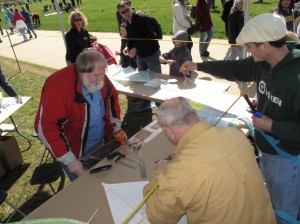
By Katherine Sundt
UJW Staff
WASHINGTON — Mason Pickett reports the bad news: “The doctor says it’s terminally ill.”
The patient is in front of him folded limply in the arms of his daughter, Sarah, apparently missing a part that the doctor doesn’t have in stock.
Though obviously disappointed, the two try to stay upbeat despite the gloomy diagnosis.
They move on and the next patient steps up to see John Oxenham, who is the kite doctor.
Oxenham was the fixer of all things broken and ailing at the 44th annual Smithsonian Kite Festival on the National Mall.
Flocks of locals and tourists attended the festival on March 27 — some to compete in the various contests being held, but most just to fly kites and enjoy the nippy yet sunny weather.
With the Washington Monument towering behind him and the scent of cherry blossoms in the air, the kite doctor’s operating room is a set of tables assembled under a square white tent.
Kite fliers like the Picketts gather around Oxenham’s tent in hopes that he can get their beloved kites soaring again. The line wraps around the side of the tent, the owners’ colorful contraptions cradled in their arms.
Oxenham systematically attends to each of his patients, carefully wielding his bright orange-handheld saw with Scotch tape and scissors at the ready.
One devoted kite owner, Amar, who declined to give his last name, tries to repair his kite himself on one of the tables under the tent, rather than wait for the doctor.
Amar explains that he is adding tape to the right side of his kite to weight it down because it kept spinning to the left.
He is competing in the Kite Festival for the first time. His creation: a simple yet elegant ivory-colored kite.
“I used to fly kites in India not so long ago, and I still want to fly them,” he says.
Pickett, the man with the sick kite, had been waiting in line for about half an hour with his daughter, hoping that the kite doctor could help them. They suspected the problem was that their triangular red and yellow-striped kite was missing a key element: a tail.
“It’s been sitting in our garage for a few years,” says Mason Pickett, who lives in northern Virginia. A white logo imprinted on the kite reads “©1979.” Normally they just fly kites at the beach, but thought the Kite Festival seemed like a “nice thing to do.”
When the Picketts finally reach the front of the line, the kite doctor, who could double for Santa Claus with his full white beard, is eager to help. But he soon informs them that it’s not the tail they should be worried about but a small metal piece that should be at the tip of the kite.
Unfortunately, the doctor doesn’t have the crucial piece in any of his boxes of spare parts.
All is not lost though. A few minutes after they learn that their kite is “terminally ill,” they return once more to see the kite doctor because they have found a large, unusually thick paper clip that they hope the doctor can manipulate to substitute for the missing part.
“We’re going to see if the doctor can perform some sort of plastic surgery,” says Mason Pickett.
They are relieved to find out that their kite can be salvaged. Oxenham makes a few quick repairs and sends the Picketts off for a test flight.
“We’re gonna go make an attempt at something here,” Mason Pickett said.
The Picketts walk to the center of a fenced-off practice field and a few seconds later the colorful kite is lifted by a strong gust of wind. Despite lacking a tail, it joins the hundreds of brightly colored triangles, dragons and butterflies drifting in the sky.
The Kite Doctor has saved another patient once diagnosed terminally ill.


